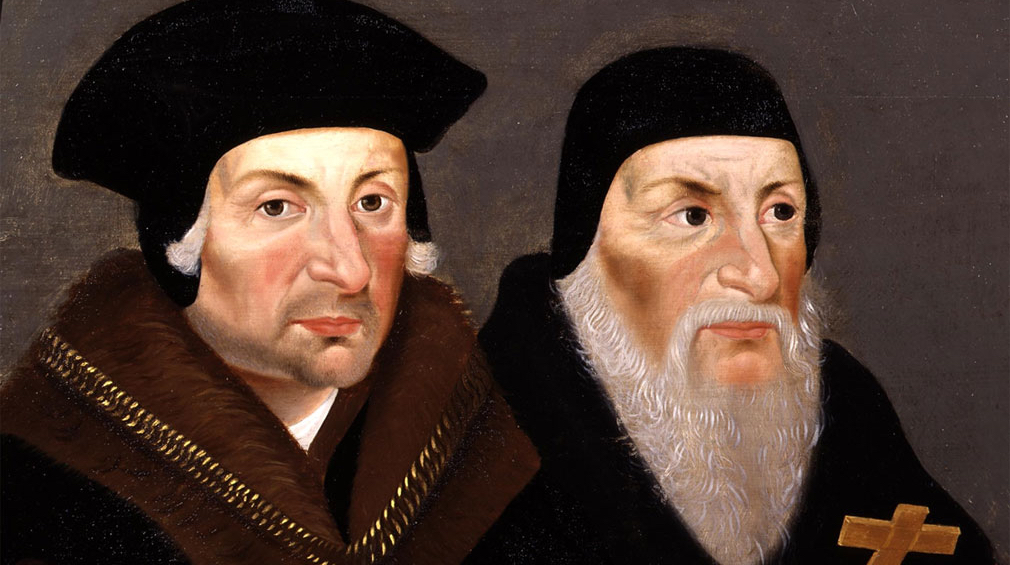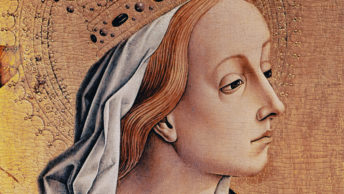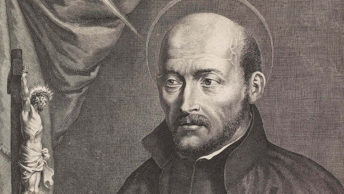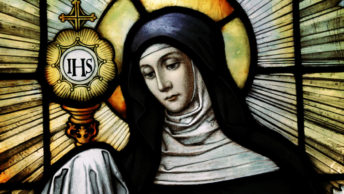As the corporal works of mercy help our neighbor in the needs of his body, the spiritual works of mercy aid our neighbor with the needs of the soul. As life on this Earth is passing and eternity forever, you can guess which of the two the Church views as the most important!
The Catechism of the Catholic Church says, “Instructing, advising, consoling, comforting are spiritual works of mercy, as are forgiving and bearing wrongs patiently.” (2447)
The first spiritual work of mercy is “admonish the sinner.” St. John Fisher (1469-1535) is an excellent example of this work of mercy. John was born in England, ordained a priest at age 22, and was known for his great learning and humble life. He was appointed bishop of the poor Diocese of Rochester, where he remained throughout his life.
The King of England, Henry VIII, had once been a great defender of the Church (and awarded the title “Defender of the Faith”), but broke with Rome when he publicly divorced his wife Catherine so that he could marry another. All the nation’s bishops feared the king’s authority and went along, but not John. John outraged the king when he declared he would die for the Church’s teaching about the indissolubility of marriage.
Henry founded the Church of England and made himself its head. He arrested John Fisher and had him thrown into the Tower of London. He suffered martyrdom by being beheaded. John was willing to give his life to correct the errors of Henry.
The second spiritual work of mercy is “instruct the ignorant.” This begins with us sharing our faith with others, explaining accurately what we believe and why. We must educate ourselves in the faith to be ready for such a moment and ask Our Lord for opportunities to share our faith.
1 Peter 3:15-16 “Always be ready to make your defense to anyone who demands from you an accounting for the hope that is in you; yet do it with gentleness and reverence.”
Many of the Church’s heroes, the saints, have devoted their lives to instructing the ignorant about the truths of the faith. One example is St. Dominic (1170-1221), founder of the Dominican Order (Order of Preachers). Dominic came from a wealthy family and was dedicated to prayer. He became a Benedictine before starting his own order.
He was called on the fight the Albigensian heresy in southern France, which taught that matter was evil and spirit was good. Hence, some considered suicide a good act. Taking the example of the first apostles, Dominic and his fellow Dominicans went out, two by two, begged their bread and based their preaching on sound doctrine. Legend has it that in 1214 the Blessed Mother gave St. Dominic the rosary to help him convert the Albigensians.
Legend also has it that Ss. Peter and Paul appeared to him and gave him a staff for guiding others and a book to do so by the truth. They told him, “Go and preach, for you are chosen by God to do that occupation and ministry.”
Future Dominicans included the great teachers Ss. Albert the Great and Thomas Aquinas.
Next comes “counsel the doubtful.” We draw upon Scripture to give us guidance in speaking with people.
1 Corinthians 1:25 “For the foolishness of God is wiser than men, and the weakness of God is stronger than men.”
We don’t need to explain things with human logic, but rather, we draw our strength from the Holy Spirit. We let God speak through us.
Padre Pio (1887-1968) was an Italian friar popular with many Catholics today. He received the stigmata, the wounds of Christ in his hands and side, and was given many special spiritual gifts: healing, bilocation, levitation, prophecy and reading hearts.
But he is perhaps best known for the many long hours he spent counseling the doubtful in the Sacrament of Penance. Among those who came were the future Pope John Paul II, whom Padre Pio predicted would be elevated to the highest ranks of the Church.
The fourth spiritual work is “comfort the sorrowful,” which leads us back to the beatitudes in Matthew’s gospel.
Matthew 5:4 “Blessed are they who mourn, for they shall be comforted.”
We must be listeners, actively present to others. When we act in this way, we become Jesus to them! We reassure them that they are not alone, that we—as Jesus does—love and care about them!
St. Maximilian Kolbe (1894-1941) was a Polish Franciscan martyr. He did much to challenge the errors of his day, including Nazism. He published a magazine, “The Knight of the Immaculata,” and preached on the radio.
The Nazis arrested him and sent him to the death camp Auschwitz. In 1941, one man escaped, so the Nazi guards chose 10 men to die in his place. Maximilian famously volunteered to take the place of a married man who had been among the 10.
In his last days dying in the group cell with the other nine, Maximilian did much to comfort the sorrowful. He celebrated Mass for them, and led them in singing hymns. He told them, “You’ll soon be with Mary in heaven.”
Maximilian was the last to die; he was canonized by Pope St. John Paul II in 1982. The man whose life he had saved was there in Rome to witness it.
The next work of mercy is “bear wrongs patiently.” Each of us is hurt and will be hurt by others. Often these hurts can lead to depression and a great deal of anxiety. What do we do? First, we pray for those who injure us. Second, we picture them with the eyes of Jesus. Are they loved by Jesus? Forgiven by Jesus? When we see others as Jesus does, our attitude changes, often immediately.
St. Andrew Dung Lac (1795-1839) was born into a poor family in Vietnam. He converted to Catholicism as a teen, and was ordained a priest in 1823. He lived an exemplary Catholic life, praying, fasting, living a simple life and preaching the Gospel.
Unfortunately, the emperor in Vietnam at the time, Minh Mang, hated the Catholic faith. He martyred Catholics, banned missionaries and tried to get Catholics to renounce their faith by stomping on a crucifix. Andrew had to hide from the authorities. He was eventually caught, tortured and beheaded.
The persecution continued. Christians’ faces were marked with the words “ta dao” or false religion. Families were broken up, and villages destroyed. Andrew and his fellow Vietnamese Catholics had to bear wrongs patiently until the political situation in the country improved.
Andrew was one of 117 Vietnamese martyrs canonized by Pope John Paul II in 1988. Many Vietnamese people today still honor the image of Our Lady of La Vang, a 1798 apparition of Mary during which she gave encouragement to the people in the midst of their sufferings.
“Forgive all injuries” is the next spiritual work of mercy. St. Philip Benizi (1233-85) was a Servite priest was sent by the pope to the City of Fortli in the former Papal States. While he was preaching, an angry 18-year-old man named Peregrine Laziosi struck him in the face, knocking him down. Peregrine immediately repented, and Philip readily forgave him. Peregrine was converted by the kindness and mercy of the saint, joined the Servite order and became a saint himself. Philip’s readiness to forgive an injury converted a sinner and set him on the path towards becoming a saint.
The final spiritual work of mercy is “pray for the living and the dead.” Returning to Padre Pio, this great saint has many stories about helping the souls in Purgatory. One evening, for example, he was praying in church and heard noise. He thought a candle had fallen, but looking up, saw a young brother cleaning. “What are you doing?” Padre Pio asked. “Cleaning,” the brother responded. “In the dark?” the future saint asked. “I was part of this community, now I spend my Purgatory cleaning here.” Padre Pio took it as a prompting that he should pray for the man’s deliverance from Purgatory.
All of us can engage in the spiritual works of mercy. Start with your family and friends and others with whom you are in close contact. Then you can expand your efforts to assist a larger number of people, perhaps through a ministry in your parish.
And remember, our prayers and efforts to help our neighbor are critical to his salvation. In one of the most memorable of the apparitions of Mary to the three children of Fatima, Portugal, in 1917, she showed them a terrifying vision of hell. She then told the children, “You have seen hell where the souls of poor sinners go. To save them, God wishes to establish devotion to my Immaculate Heart. If what I say to you is done, many souls will be saved and there will be peace.”
Like the children of Fatima, let us pray for our neighbor, and look for other ways we can help him in his spiritual needs.








